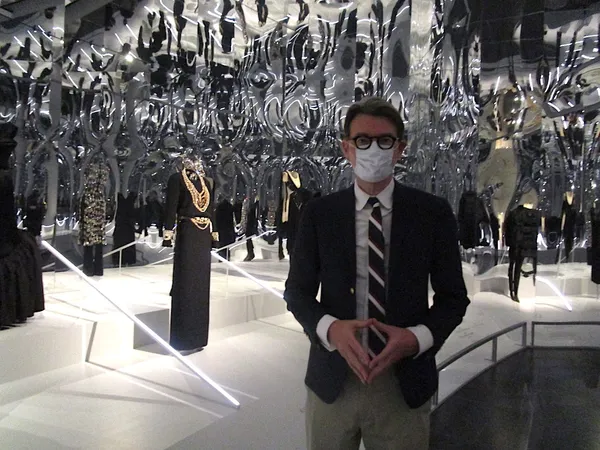In Christian D Bruun's Calendar Girl (a 2020 DOC NYC highlight), which features interviews with the who’s who of the fashion world (including Bill Cunningham, Carolina Herrera, Thom Browne, Fern Mallis, Harold Koda (former curator-in-chief of the Anna Wintour Costume Center at The Metropolitan Museum of Art), Diane von Furstenberg and Steven Kolb (CEO of the Council of Fashion Designers of America), we see Andrew Bolton stroll through the China: Through the Looking Glass exhibit with Ruth Finley, creator of the Fashion Calendar.
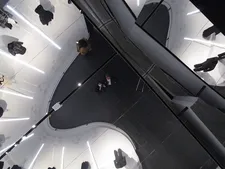 |
| Andrew Bolton with Anne-Katrin Titze: “I wanted to use the Phillip Glass soundtrack for The Hours” Photo: Anne-Katrin Titze |
At the in-person press preview for About Time: Fashion and Duration, Andrew Bolton (the Wendy Yu Curator in Charge of the Costume Institute at The Metropolitan Museum of Art) told me how Meryl Streep’s practical suggestion made it possible for us to hear her co-stars from The Hours, Nicole Kidman and Julianne Moore, and herself read excerpts from Virginia Woolf’s Orlando: A Biography in the galleries and how Michael Cunningham, who wrote a new short story, Out Of Time, published in the exhibition’s splendid and extensive catalogue, was never far from his mind while working on the show.
Andrew took me on a little tour to his favourite pieces - an 1877 princess line afternoon dress coupled with Alexander McQueen’s Bumster skirt - as we spoke about Virginia Woolf’s concepts of linear and cyclical time, Henri Bergson, clothing and longing. The exhibition, whose opening was postponed from the first Monday in May to this week, due to COVID-19, offers a sensory experience that oscillates in making us feel at different points in time as inside a clockwork, fractured by Versailles mirrors, an ant on a melting Dali clock above or a chess figure, greeted by the best-dressed companion ensembles from The Met’s archives on the 150th anniversary.
Anne-Katrin Titze: It’s a beautiful exhibition, more beautiful than I imagined after all we have been through. Last year when we spoke …
Andrew Bolton: … at Camp: [Notes On Fashion].
AKT: No, even after that, at the [Sandy] Schreier exhibit [In Pursuit of Fashion] last fall.
AB: Oh that’s right, yes, of course yeah.
AKT: You were telling me, oh, I don’t know, it’s so complicated with Virginia Woolf.
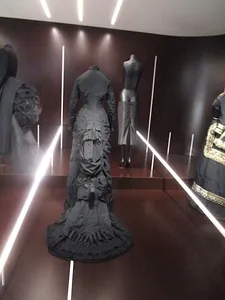 |
| Andrew Bolton on 1877 Afternoon Dress with Alexander McQueen’s 1995 Bumster Skirt: “It’s my favourite juxtaposition” Photo: Anne-Katrin Titze |
AB: Yes!
AKT: Now you did it.
AB: Oh gosh.
AKT: Was there a moment when you knew that this is how you wanted to do it?
AB: It was interesting, because the original idea for the show was really straightforward. It was, as you know, the Met’s 150th anniversary and I wanted to do a show that reflected our collection, our permanent collection. But I didn’t want to do a masterworks show and I love timelines.
But I didn’t want to do a straightforward timeline. It’s educational but I feel fashion has moved on from that. So I was reading through Virginia Woolf and I began thinking about doing a show that was a meditation on fashion and temporality.
AKT: What were you reading by Virginia Woolf then?
AB: I was reading two, the famous ones, Orlando and Mrs. Dalloway. And what I thought was really interesting about her is that when she began her career as a writer, the way she approached time was very traditional, you know, it was chronological. So events succeed each other in time. It was a very traditional approach to fashion, [Andrew corrects himself immediately] to time. And as she matured as a writer, she began to see objective time almost as the enemy and her work became much, much more about subjective time, really durée which is what Henri Bergson is about.
So it was really through Virginia Woolf that I began to think about Henri Bergson and notions of subjective time. The subjective time of the mind being different from the objective time of the clock. I wondered how could we actually present that as a concept in an exhibition within time. So we came up with this idea of these two timelines. Obviously you have the first timeline from 1870 when The Met was founded to the 2020 Viktor & Rolf at the end.
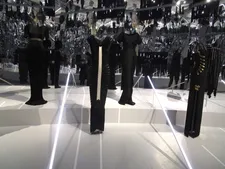 |
| Azzedine Alaïa 1994 Dress with Charles James’s La Sirène 1939 Evening Dress: “Alaïa, for example, this piece is a complete love letter to Charles James” Photo: Anne-Katrin Titze |
That’s the first timeline, which is this traditional, chronological timeline, which is about how fashion is progress-oriented, forward moving, it’s about novelty, it’s about obsolescence, it’s about ephemerality. The second timeline is a structive timeline, where we have garments that relate to the timeline piece in terms of silhouette or motif or material. What I wanted to do by doing that was to show that, you know, one aspect of time is about succession, it is about the successive moments in time. As a matter of fact, another aspect of time is where the past and present coexist together.
AKT: Also the circular time.
AB: Exactly! It’s linear time and circular time exactly. How the chemise comes back in the Sixties, the circularity of fashion. What I found so interesting was when you do this, when you see the garments together in these tick marks, it sort of takes them outside of time.
AKT: Very true.
AB: It takes them outside of the confines of chronology and it gives them a sort of autonomy to exist together outside of chronology.
AKT: It’s almost as To The Lighthouse.
AB: Very much.
AKT: We are always going to the lighthouse. A part of us is always the child who wants to go to the lighthouse tomorrow and can never go, because it doesn’t exist in time. This exhibition here feels a bit like arriving at a lighthouse.
AB: Oh thank you! It’s a nice idea because I love that novel. And it’s such a complicated novel to understand. And Woolf is so … it took me a long time … I cracked it eventually. I always loved her, but she wasn’t easy for me to read because of the stream of consciousness, because basically it’s stream of consciousness.
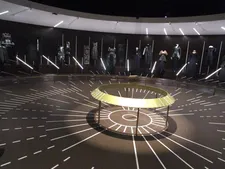 |
| Andrew Bolton on About Time: Fashion and Duration: “The subjective time of the mind being different from the objective time of the clock.” Photo: Anne-Katrin Titze |
AKT: And what she does with time! Sometimes it’s only the flowers on the table that make it possible for us to identify which season and year we are in and where we are at.
AB: Absolutely. It’s so subtle. I envy her. My thoughts are always a stream of consciousness, they’re always like that. But when you jump right in, I could have imposed an order on it. So I envy her not having to impose too much of a structure on her thoughts and she can let her stream of consciousness develop and evolve instead of imposing a structure. Sometimes it’s difficult but with this one I think it worked out.
As we were saying earlier, I feel as if … I love shows, I always try with shows, even with Camp, to have a theme that exists outside the confines of the exhibition or the confines of the museum. So with Camp obviously it was relevant and still is. I think now the way we think, with everyone being at home, I don’t know about you, but time is either contracting hugely or expanding hugely. The way you think about time is so different than it was six months ago.
AKT: Yes, totally.
AB: Totally different.
AKT: This second room is like Versailles, when you enter, the mise-en-abyme.
AB: All the mirrors.
AKT: It's similar to what you did with Camp, the first rooms with the history and then the colour and the sudden expanse.
AB: I wanted to look at the endless repetition of fashion. The idea that fashion has accelerated or time’s accelerated and fashion is reflecting that acceleration. I didn’t want to have numbers. I hate that thing on Union Square [Kristen Jones/Andrew Ginzel Metronome on 14th Street], the death clock.
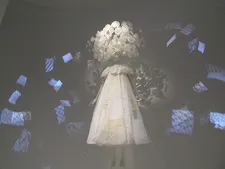 |
| Viktor & Rolf 2020 Dress: “Its patchwork design serves as an apt metaphor for the future of fashion and the importance of community, collaboration, and sustainability” Photo: Anne-Katrin Titze |
AKT: I do too. It’s so ugly.
AB: It makes me so depressed. I thought this could be the same where you have this ticking clock which talks about the constant acceleration of fashion. It was too depressing and I wanted to do something poetic which showed how fashion is accelerating and multiplying. So we thought mirrors was a nice way of doing that without it being too heavy-handed. It was Es [Devlin]’s idea.
AKT: When you come in and look up to the ceiling, and even here, it looks like a Dali clock that’s melting.
AB: It does! It does very much, doesn’t it?
Nancy Chilton [Chief External Relations Officer for The Costume Institute]: I never really noticed that, yeah!
AKT: It’s great.
AB: It also looks a bit like a chessboard.
NC: It’s an [MC] Escher in a way.
AKT: Right. I love, love the 19th century pieces you picked!
AB: Oh, me too. My favourites.
AKT: The ones at the very start!
AB: I think my favourite is the princess line and the Bumster. I was talking to a journalist earlier and he was saying, is there anything that you found surprising. For me the Bumster was one of the most radical designs in the last twenty years because it was that design that elongates the torso by exposing the base of the spine and the top of the bottom.
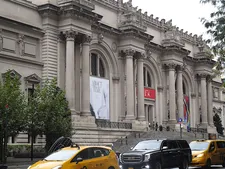 |
| About Time: Fashion and Duration banner at The Metropolitan Museum of Art Photo: Anne-Katrin Titze |
And when I was working on the show, I was like, actually the princess line did this in the 1870s. Yes, you were covered but if you took the top part of the princess line off, you’d have a Bumster. So I love that. It’s my favourite juxtaposition, that one. I think what’s interesting is that fashion does look back often, it does repeat. But it reinvents and it reinterprets and it recontextualises. So something like the princess line, I’m sure Lee, [Alexander] McQueen, had no idea that this was what he was doing, but he loved the princess line silhouette.
AKT: True!
AB: And if you go through his work, it repeats again and again and again. And this was just a radical version of it, with the top cut off. So that’s my favourite. [Later Andrew walks me over to it and points out some details]. Yes, one could quite easily say fashion is just repeating itself. I don’t believe that. It does, of course, but I do think it reinterprets and recontextualizes, it reinvents and I think that’s part of the creative process.
AKT: Especially now, that we so often do not really dress to our full potential. When you sit at home, you don’t really dress up. I think the rare person does that.
AB: Very rare.
AKT: So fashion reflects our social being. It is our social being that is out there. That’s where a sense of longing and a sense of openness comes into it (I am pointing around the exhibition).
AB: That’s so lovely, I haven’t thought about that. No, that’s exactly right. I think there is a longing for the past. They are also love letters to each other and conversations between designers. [Azzedine] Alaïa, for example, this piece is a complete love letter to Charles James, you know. He had Charles James in his archive, he was a great fan of Charles James.
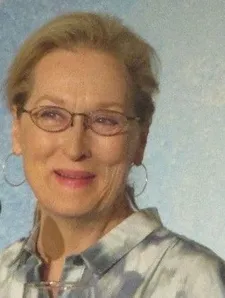 |
| Andrew Bolton on Meryl Streep reading Virginia Woolf: "She did this amazing recording in her house with this 18th century clock in the background, so beautiful." Photo: Anne-Katrin Titze |
AKT: That makes perfect sense, those two together.
AB: He made this dress that is radically different. Clearly it’s like the siren dress for inspiration. So that to me is a love letter.
AKT: Last point on the actresses from The Hours [The voices of Nicole Kidman, Julianne Moore and Meryl Streep are heard in the galleries reading from Virginia Woolf's Orlando: A Biography].
NC: I was waiting for you to get there!
AB: No one has asked me that!
AKT: Of course, for Eye For Film it has to be a question! I kept it for the end. How did that come about?
AB: First of all I approached Michael Cunningham, who wrote The Hours, to write a new piece for the book. He was onboard straightaway. We spent a few meetings talking about what that was going to be. The Hours, Michael’s novel, was always in my mind. And then when I was doing the music for the show, I wanted to use the Phillip Glass soundtrack for The Hours.
And about three weeks ago, I said, my gosh, it would be great to get Meryl, Nicole, and Julianne, too, to do the reading from Virginia Woolf, to amplify her presence too. It also connected to The Hours and this idea of the past and the present go backwards and forwards. So I approached them all.
Meryl got back straight away and she did this amazing recording in her house with this 18th century clock in the background, so beautiful. And I was worried, because she let me know that Julianne and Nicole were shooting. So they were super busy. But Meryl came up with this great idea: Just ask them to record into their iPhones, because they won’t need a recording studio and it won’t be so onerous on them. So I e-mailed them again, saying, you know, is that possible? And that’s what you are hearing! It’s Meryl, Nicole, and Julianne talking, speaking this beautiful reading of Virginia Woolf in their iPhones. Technology is amazing.
AKT: Congratulations! It’s beautiful work.
The world premiere of Calendar Girl will screen virtually in the Metropolis competition at DOC NYC starting on Wednesday, November 11 through Thursday, November 19.
The Costume Institute exhibition About Time: Fashion and Duration at The Metropolitan Museum of Art runs from Thursday, October 29 through Sunday, February 7, 2021.








